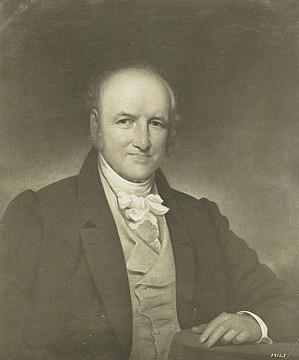Robert Lenox (1759-1839)
Merchant & President of the New York Chamber of Commerce
He was born at Kirkcudbright in Scotland in straightened circumstances - his grandfather having lost his estate (Milnhouse) to the Earl of Selkirk in a game of cards. He and two of his brothers (William and David) were sent to America when he was about fifteen - just before the Revolution - to work for his uncle, David Sproat, a successful merchant in Philadelphia. He was briefly schooled in Burlington, New Jersey, before joining his uncle in New York who was then (1779) the British Commissary-General of Naval Prisoners in North America. He made frequent voyages on behalf of his uncle's business interests between New York, the West Indies and Charleston. He was taken prisoner by a French man-of-war but was released upon the request of his brother, David Lenox, who had by then become a Major in the Continental Army.
When the Loyalists were evacuated from New York he briefly returned to Scotland to help settle his uncle's accounts, but settled permanently in New York from 1784 as a shipping and commissions merchant, and President of the Mutual Insurance Company, the first fire insurance company in New York City. In 1796, his youngest brother, James, established Lenox & Maitland at New York with which he was intimately connected.
Lenox rapidly amassed a fortune in the East India trade and in 1830 he was named as one of New York's five millionaires along with John Jacob Astor, Stephen Whitney, Nathaniel Prime, and John G. Coster. He invested his fortune in land, most notably purchasing 30-acres between Fourth and Fifth Avenues, bounded by 68th and 74th Streets. The area was referred to as the "Lenox Farm" and had cost him $6,920 in 1818. After it was developed by his son, James, from the 1860s it became known as the Lenox Hill neighborhood of the Upper East Side, and one of the most valuable slices of real estate on Manhattan.
He was President of the New York Chamber of Commerce; Alderman of the City of New York; President of the Saint Andrews Society; co-founder and President of the Lying-In Hospital; Chairman of the Sailor's Snug Harbor; Trustee and Chairman of the Committee of Finance at Princeton College; and, an Elder of the First Presbyterian Church. He was a Federalist and strong exponent of free trade sent as a delegate to the convention in Philadelphia in 1820. Before 1805, he lived at 175 Pearl Street but from then until his death made his home at 59 Broadway. He was married in 1783 to Rachel, daughter of Nicholas Carmer. They were the parents of twelve children of whom eight (listed) survived to adulthood. Their daughter, Alethea, married the brother of Robert Donaldson of Blithewood; and their only son, James Lenox, founded the New York Public Library.
When the Loyalists were evacuated from New York he briefly returned to Scotland to help settle his uncle's accounts, but settled permanently in New York from 1784 as a shipping and commissions merchant, and President of the Mutual Insurance Company, the first fire insurance company in New York City. In 1796, his youngest brother, James, established Lenox & Maitland at New York with which he was intimately connected.
Lenox rapidly amassed a fortune in the East India trade and in 1830 he was named as one of New York's five millionaires along with John Jacob Astor, Stephen Whitney, Nathaniel Prime, and John G. Coster. He invested his fortune in land, most notably purchasing 30-acres between Fourth and Fifth Avenues, bounded by 68th and 74th Streets. The area was referred to as the "Lenox Farm" and had cost him $6,920 in 1818. After it was developed by his son, James, from the 1860s it became known as the Lenox Hill neighborhood of the Upper East Side, and one of the most valuable slices of real estate on Manhattan.
He was President of the New York Chamber of Commerce; Alderman of the City of New York; President of the Saint Andrews Society; co-founder and President of the Lying-In Hospital; Chairman of the Sailor's Snug Harbor; Trustee and Chairman of the Committee of Finance at Princeton College; and, an Elder of the First Presbyterian Church. He was a Federalist and strong exponent of free trade sent as a delegate to the convention in Philadelphia in 1820. Before 1805, he lived at 175 Pearl Street but from then until his death made his home at 59 Broadway. He was married in 1783 to Rachel, daughter of Nicholas Carmer. They were the parents of twelve children of whom eight (listed) survived to adulthood. Their daughter, Alethea, married the brother of Robert Donaldson of Blithewood; and their only son, James Lenox, founded the New York Public Library.
Parents (2)
Children (8)
Categories
Share
Image Courtesy of the Frick Art Reference Library
https://archive.org/details/genealogicalnote00bank/page/n15/mode/2up
https://archive.org/details/genealogicalnote00bank/page/n15/mode/2up








